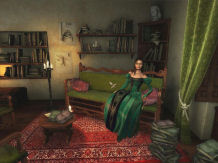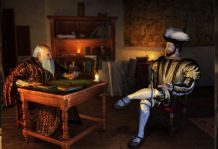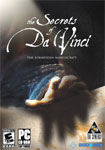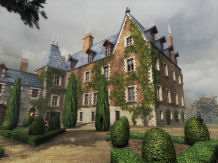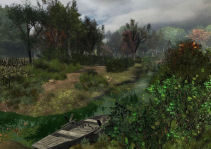The Secrets of Da Vinci: The Forbidden Manuscript,
hereafter known as Secrets, is a first person, point-and-click,
mouse controlled adventure game. It tells the tale of a somewhat
antiheroic “hero” searching for a fabled artifact, not amongst ruins or
savage wilds, but in a luxurious manor house in 16th century France. He
seeks the artifact, not to save the world, but for financial gain. Yet
his story intrigued me and I found myself rooting for him to succeed.
Trivia: Cloux Manor was built between 1107 and 1115 of pink brick
from local quarries.
The best stories are woven around truth, and this one is no exception.
Near the end of his life, Leonardo Da Vinci lived for a few years in Cloux
Manor and died there. He was a confidant of King Francis I. There is a
tunnel connecting the King’s castle and the manor. Madame Babou de la
Bourdaisiere lived for a time in the manor after Leonardo’s death. The
game’s developers took selected facts such as these and used them to weave
a rich tapestry of imaginary details for our enjoyment. They decorated
the manor with Leonardo’s paintings and sketches and utilized some of his
inventions in puzzles, thus giving us an immersive adventure anchored in
realism.
The story is set in 1522, three years after Leonardo’s death. It is
told through flashbacks, manuscripts, and conversations. The well written
dialogue has branching paths. Sometimes the response chosen changes the
gamer’s path. Sometimes, but not always, the dialogue can be repeated.
Though not an intricate plot, I was engaged by it and looked forward to
playing.
Near the end of the game I was jolted to hear a line of dialogue giving
one character an impossible age. I think this is a mistake, as it makes
no sense in the plot or timeline. I am surprised this error (if it is
one) survived beta testing. It was one of the few inaccuracies I noted in
the game.
Trivia: Francis I played war games in the manor gardens as a
young duke.
The characters in Secrets are multifaceted, detailed, and
individualized. No “good as gold” hero here. Valdo is a talented young
artist whose poor judgment (possibly combined with greed) has cost him his
place as a student of Francesco Melzi, who was himself a student of
Leonardo Da Vinci. Valdo agrees to steal a very famous, perhaps mythical,
document. But first he must find it. As his financial “deal” is with an
unknown person, we might say that his judgment is not improving. Or
perhaps he simply likes the excitement.
In any case, Valdo arrives at Cloux Manor under false colors. One of
the many choices the gamer makes is how forthcoming to be with Madame
Babou, current resident of the manor. Should Truth rule the day with its
possibility of ejection and failure? Or is this the time for a judicious
lie? Should Valdo prevaricate and flatter outrageously? Or keep to the
straight and narrow as much as possible? You decide!
Your choices determine the path you play and influence your
relationships with some of the characters. They do not radically alter
the game play, but they do have an impact. For instance, I stole from one
character and he ceased to help me for awhile as a result.
Valdo is an interesting, if flawed hero, and he interacts with
characters just as complex. The first he meets is Saturnin, the roguish
servant of Madame Babou, and later he meets the lady herself. Their rich
and distinctive personalities are revealed as the game progresses.
The gamer also gets to know Leonardo a bit, courtesy of cut scene
flashbacks. Valdo chats with a few other characters from time to time,
but I’ll leave those for you to discover.
All the characters are well drawn and move fluidly. Authentic details
add to the game’s believability, and the fact that the characters are not
always found in the same spot adds charm. I particularly was taken with
Saturnin. The details on his close-up views are excellent. His
expressions are always appropriate, his hands lifelike, his gestures
flowing, his clothing slightly grimy. His mouth is well synchronized with
his speech.
Research after the fact reveals that the models of King Francis and
Leonardo are quite true to life. However, while all the characters are
well done, the others did not have the depth of Saturnin. For example,
Babou’s clothing is detailed, but her skin lacks the shading of Satunin’s
and her hair perches ‘stiffly’ upon her shoulders instead of streaming
fluidly. I found this distracting given the excellence of the other
graphics.
Trivia: The dovecote, which still stands today, can house 500
pigeons.
Secrets is a beautiful game, full of shadows and rich textures.
The opening and closing cut scenes are cinematic. Photorealism rules the
day. While doing some research, I found photos of the present day Cloux
Manor and immediately recognized certain areas that I had just visited in
the game.
As befits a game set in the 16th century, overhead candle chandeliers
provide pockets of light alongside shadowed corners. In spite of this,
the game is not dark and does not, with one exception, call for anything
resembling pixel hunting. Light glows luminously through the stained
glass chapel windows and peeks through cracks in cellar shutters, all
providing a rich ambiance ripe for exploration.
Cloux Manor provides both a formal garden and a wilder creek area to
explore. My one complaint about the outdoor areas is their static nature.
Inside the manor, candlelight flickers, cooking fires shimmer, and smoke
wafts from the chimneys. But outside everything is still. Trees are
gorgeous, but no leaf moves. The creek is charming, but utterly
stationary. People move through the environment, but -- with the
exception of two areas involving puzzles -- no insect or animal appears
there. Picky, I know. But with each outdoor excursion I felt this
disconnect, drawing me away from total immersion.
Trivia: The chapel was built by Charles VIII for his Queen in
remembrance of her children’s untimely deaths.
Secrets’ voices are excellent. The cadence and phrasing is
natural. Each character’s voice “fits” the person he or she portrays and
all are easy on the ear.
The ambient sounds are outstanding and immersive. Floors creak, owls
hoot, horses neigh. Footsteps echo.
The background music blends strings and wind instruments and appears
intermittently. Mostly it is pleasing and atmospheric. I did mute the
sound when working on a difficult puzzle, as the music annoyed me in that
circumstance. Also, there is one area in which the music struck a
discordant, overly modern note -- but in general, the music works.
Trivia: Forty machines, designed by Leonardo, have been
recreated using materials found in his time and are displayed at Cloux
Manor.
Secrets features many inventory driven puzzles, but it also has
logic puzzles, a riddle, mechanical puzzles, a little code breaking, one
fairly easy sound puzzle, and one very difficult slider.
Many of the puzzles contain multiple steps, and most of them flow
naturally from the story and the setting. There is one puzzle calling for
a bit of stealth. There are two puzzles requiring color discrimination.
(For the most difficult one, I discovered the puzzle solves itself if you
begin it, then Alt+Tab away and back again.)
Most of the puzzles are logical. I don’t remember a single outlandish
one. However, I have learned that you can come to a dead end by mixing
the wrong ingredients in the still, as it is impossible to empty it. Wait
for a recipe before adding items to the still.
I enjoyed solving puzzles inside the portfolio. It is clever and
innovative. I am also impressed that often the inventory items required
were available in more than one place. This eliminates some pesky “to and
fro” movement. Also, some of the tasks could be accomplished in more than
one way, a feature which I greatly appreciate and which adds replay value
to the game. Several puzzles involve machines that Da Vinci designed,
thus contributing greatly to the realism of the game.
Two tasks can lead to death, but in both you are immediately returned
to the instant before your death in order to try again. Neither task
required more than a few deaths before the “aha” moment struck.
There are no mini-games or timed sequences.
Trivia: Cloux Manor has belonged to the Saint-Bris family since
1802.
Secrets is a nonlinear game. You can poke around at will. It is
a 3D game featuring 360 degree camera panning. Fortunately, the panning
speed can be slowed.
It includes a paper manual and Disk Two must be in the drive to play
the game. Options include subtitles, camera speed, and volume control. The
“smart” cursor changes automatically to indicate possible actions.
The game is Alt+Tab friendly and allows unlimited saves.
Unfortunately, saves are automatically named with a time and date stamp
and a small picture. As you may visit the same area multiple times, this
picture may not be particularly helpful in identifying a specific save.
Secrets allows up to five different gamers to play without
overwriting the other saves. Although this is not a feature I need, I can
see its usefulness in multi-gamer households.
This is an inventory heavy game. As such, it requires an effective and
intuitive inventory interface -- and it has one.
The inventory system is elegant and instinctive -- reminiscent of the
inventory in Return to Mysterious Island. It includes five pages
of inventory slots, allowing the gamer to organize items using whatever
system she prefers. The inventory page also includes a diary, a
portfolio, a hero portrait, a conscience gauge, bonus points, money, and
allows access to the main menu. You will visit it often.
Trivia: Cloux Manor was built on Gallo-Roman foundations and was
once fortified.
The diary automatically enters important information from
conversations, and keeps a running “to-do” list. As tasks are completed,
they are checked off.
All documents procured throughout the game are stored in the
portfolio. It acts as a separate inventory for documents and as a puzzle
interface. Valdo usually must interact with the documents before they
reveal their secrets. It also contains a text area where the beautiful
but illegible writing is translated to a clear script.
The photo area features Valdo and later in the game, Valdo and Babou.
It serves as an area to change Valdo’s clothing and also indicates the
state of his relationship with Babou --an inventive touch.
Valdo’s actions are reflected in his conscience gauge. It begins
evenly divided between “good” and “bad.” Too good or too bad, and he may
not be able to perform certain necessary tasks. There is no danger of a
dead end here, though you can change the balance of the gauge with money
(providing you have some, of course).
I liked this gauge. I ended the game with my “angelic” scale twice as
high as my devilish one. It would be interesting to replay the game trying
to be only good or only bad, and to take some of the paths that I chose
not to take the first time.
I found two endings to the game, but there may be more. Left clicking
ends the credits – this allows the gamer to leave the game via the menu
interface instead of being forced to Ctr+Alt+Delete.
Trivia: Leonardo died at age 67 leaving the bulk of his estate
to Francesco Melzi.
Although Secrets installed without a hitch and mostly played
like a charm, I experienced a few non-repeatable glitches. For instance,
at one point a puzzle I had solved reappeared unsolved. The game would not
allow me to solve it again, nor would it allow me to progress. Reloading
the save ended the problem.
Once, a goal was marked off even though I had not finished the task. I
had to restart from a save in order to obtain that item and move the story
along.
I experienced one inappropriate remark about letting a character “sleep
it off” -- the problem being that character was wide awake. And I had
difficulty in triggering one cut scene which I fixed by redoing that
puzzle.
Other than these small problems, the game was stable.
Trivia: Other than the house where he was born, Cloux Manor was
the only permanent home of Leonardo.
I enjoyed Secrets of Da Vinci: The Forbidden Manuscript
enormously. Valdo is an engaging yet fallible hero who is easy to relate
to and cheer for. The characters he meets are complex. The graphics are
beautiful and realistic, the voices well done, the ambient sounds
outstanding, and the background music more often than not enhances the
ambiance. The puzzles are logical and range from fairly easy to “you’ve
got to be kidding” -- something for everyone. It is stable with an easy
to use interface. The story is intriguing and contains enough fact to
make it plausible and enough conjecture to make it fun.
Short List:
First person perspective
Point-and-click, mouse
controlled
Nonlinear game play
Unlimited saves, named with
time and date stamp and picture
360 degree panning which can be
slowed
Subtitles available
Alt+Tab friendly
No pixel hunting
Interesting story
Photorealistic graphics
Gamer’s choices affect the game
play somewhat
Great voices and ambient sound
Music enhances ambiance
Mostly inventory puzzles
Nice mix of other puzzles
including sound, color, logic, mechanical, slider
Most puzzles are logical
Can die, but are immediately
restored
No mini-games
No timed sequences
No mazes
Journal records important
information and “to-do” list
Fairly stable with no
repeatable glitches
Grade: A-
I played on:
Win XP Professional SP1
3.2 GHz Intel Pentium 4
Memory: 1 GB Dual Channel
DDR400 SDRAM
DirectX Version: 9.0b
Creative SB Audigy LS sound
card
All trivia in this review is from www.uk.franceguide.com.
design copyright ©
2006
GameBoomers
Group
